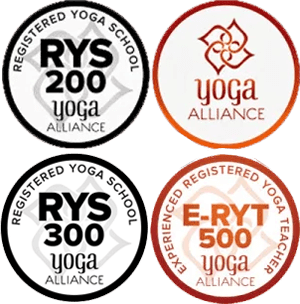Most of them find it to be a real life-changing experience as a yogic instructor. Whether one is going to be one of these devoted practitioners who wanted to share the passion or just a new career starter looking forward to becoming a yoga teacher, the journey really yields much fruit.
This is not only a chance to go deeper in the understanding of yoga but also an acquisition of some good skills that will allow someone to lead others through their personal and private journeys toward wellness. The Journey starts with completing the yoga instructor course or otherwise called as yoga teacher training course (YTTC)from reputed institute.
We take you through the stages from choosing a course up to becoming a teacher in this comprehensive guide.
Understand the Role of a Yoga Instructor
Before you go ahead to pursue certification, you have to understand what it means to be a yoga instructor. One primary aspect of doing so is therefore by teaching yoga classes.
a) Teaching Yoga Classes
The yoga teacher can lead classes through the exercise of physical postures, like asanas, breathing techniques, pranayama, and sometimes even meditation. Among the most important tasks is designing sequences of poses toward various levels-from beginners to advanced practitioners.
b. Developing a Safe and Inclusive Environment
As a teacher, you are going to be responsible for creating a safe environment in the classes you teach. This includes knowledge of body anatomy to avoid injury and having modifications for those with physical limitations.
c) Living the Yogic Lifestyle
Yoga is not just a physical activity; it has become a way of life. As an educator, you would embody these values: mindfulness (mindfulness) ahimsa or non-violence and harmony, and thus your own practice, way of life, and teaching most of the time will be interconnected.
d) Ongoing Learning and Development
Indeed, the practice of yoga is continuously evolving, and the best teachers are always learning. Perhaps this involves learning a new style of yoga, studying anatomy, or attending advanced classes on yoga philosophy. As long as a person has that sensibility to stay updated, it’s all right.
1. Reflect Your Motivation
It’s time to understand why you want to be a yoga instructor. Reflect on what motivates and encourages you into wanting to teach. Are you:
- Deepening your personal practice?
- Wanting to share with others the wellness that you experience through Yoga?
- Aspiring to be professional in the health and wellness field?
- Seeking your path of personal development and a fresh new life?
Being clear about your motivations will empower you to be present in your journey and ensure the best decision you’ll make is in choosing a program or deciding how you want to teach yoga.
2. Choose the Right Yoga Teacher Training (YTT) Program
Deciding on the right yoga teacher training course or yoga instructor course is one of the most critical decisions when it comes to getting certified as a yoga instructor. These are key considerations:
a) Yoga Alliance Accreditation
Be sure the school you select is recognized by the Yoga Alliance. The Yoga Alliance is the leading authority for the certification of yoga schools. Attainment of an RYT status is only granted to the graduates of such schools. An RYT is the minimum requirement accepted by most, but not all, yoga studios and employers.
b) 200 hour program vs. 300 hour program vs. 500 hour program:
The Yoga Alliance allows for several levels of certification. The most common is the 200-hour YTT program, or which provides fundamental knowledge in teaching yoga. Usually, after that, most teachers go ahead to take a 300-hour program, making them an RYT-500- the total being 500 hours. Each of the two entails is described as follows:
- 200-Hour YTT: This is the minimum compulsory certification to begin teaching yoga. It comprises yoga asanas, anatomy, teaching methodology, and yoga philosophy.
- 300-Hour YTT: This curriculum expands upon the 200-hour course, taking deeper dives into intermediate to advanced postures, techniques for teaching, and anatomy.
- 500-Hour YTT: A combination of both of the two courses above, certification at this 500-hour level is the most extensive, and commonly pursued by those interested in teaching niche classes or leading students.
- Hybrid YTT: Hybrid yoga teacher training is a combination of online and in-person training that offers flexibility for people who can’t attend a fully in-person program. It’s a good option for people with busy schedules or personal or social commitments
c) Select a Yoga Style
There are so many styles of yoga-from Vinyasa and Hatha to Ashtanga and Kundalini. So maybe you are drawn to a particular style of yoga. Choose a YTT which shares your enthusiasm. Rather than being vague about which style to specialize in, a well-rounded YTT that teaches several styles is probably the safer route.
d) Location and Format
The yoga teacher training programs can be received in different formats-in-class, online, or a mix of both. In-class training is most appropriate for people who wish to have hands-on exposure, while online yoga training allows a person to be flexible, especially if one has other commitments. Additionally, you can choose the local programs or “immerse” yourself in a destination like Yoga Classes in Goa where the culture of yoga is deeply ingrained.
e) Duration and Commitment
Intensive programs are available in many YTT courses that run from four to six weeks, and others come in a more fitted format to arrange around work or other commitments within weekends or months.
3. Meet the Requirements
Before joining any yoga teaching course, one has to fulfill the criteria that any such course demands. All courses, though different in their essence, share general criterias as well, which can be shown through the following points:
a) Yoga Practice
The most important prerequisite demand from students is six months to one year of continuous practice of yoga. In simple words, this means you are having elementary knowledge regarding postures and philosophy of yoga before trying to get into its complexities of teaching.
b) Physical Health
As a yoga teacher, you are expected to be in good physical health and possess the ability to execute relatively simple yoga poses. On the other hand, yoga also offers flexibility, and many different accommodations can be made for those who have physical limitations or injuries.
4. What to Expect in Yoga Teacher Training
Now that you have decided on one and enrolled, a YTT program will whisk you away on a journey of learning and self-discovery. The following is what to expect:
a) Asana Practice
You can expect to do 2-3 hours of yoga per day within all programs. You will learn complex postures; review and refine alignment; study anatomy and explore either anatomy or physiology, based on your background. Some trainings focus intimately on specific styles of yoga, whereas others teach several styles and techniques.
b) Yoga Philosophy and History
Yoga is rich in spiritual culture. Study foundational texts such as the Yoga Sutras of Patanjali, Bhagavad Gita, and more modern interpretations of yoga.
c) Anatomy and Physiology
This refers to knowing the body so you can guide students whilst still maintaining the safety of their practices. You will learn about anatomy, the activities of the muscles and joints during asanas, and how to avoid injuries.
d) Teaching Techniques and Methodology
This aspect of your training teaches you how to plan class sequences, how to give proper verbal cues, and how to adjust students. It also gives you experience teaching your fellow trainees and receiving feedback from them.
e) Pranayama and Meditation
In addition to the physical postures, yoga includes breath control (pranayama) and meditation. Techniques will be given on how to calm the mind and cope with stress and how to help students reach a more balanced state of mind.
f) Reflective Journaling
Journaling and self-reflection is encouraged in most teacher trainings to reflect on personal growth and development as participant and teacher.
5. Register with the Yoga Alliance
Upon completing your Yoga teacher training program in India, you must be registered with Yoga Alliance in order to become a certified yoga teacher. It’s pretty easy to do:
- Get Your Certification: Once you’ve completed your 200 or 500 hours of yoga training, you will receive your certification from the yoga school.
- Online Registration: Simply go to the website and apply for registration there, submitting your certificate and registration fee.
- Continue Education: To maintain certification, you must teach a required number of hours and you are afforded continuing education opportunities in the form of workshops and advanced training.
6. Start Teaching Yoga
Now that you are certified, it’s time to start teaching. Here are some choices you have for your teaching:
a) Teach in Studios or Gyms
Most new teachers of yoga find work by teaching in yoga studios or gyms. You may come in as a fill-in, taking on more and more classes until you build up to your own regular classes.
b) Offer Private Classes
Many teachers choose to teach private one-on-one classes. Private clients can be highly profitable. You also have the opportunity to personalize your teaching based on the specific needs and objectives of your client.
c) Teach Corporate Yoga
Corporate wellness programs become more in vogue than ever before. Teaching classes to corporate is a great opportunity for reaching out to a new segment of people and adding your teaching portfolio.
d) Workshops and Retreats
As you are growing as an instructor, organize workshops or conduct yoga retreats. There is no better way than for your students than to dive into the practice by immersing themselves in it over a weekend. It is also a super ideal way to spread yourself out as an instructor.
7. Continue Your Education
Of course, being certified is just the beginning of a lifelong journey through yoga. Ongoing education is essential to expand your knowledge and keep you abreast in an ever-changing world of yoga.
a) Workshops
Workshops offer specific advanced training in topics like advanced asanas, body anatomy, or yoga for particular populations, such as geriatric or athlete-related yoga.
b) Advanced Teacher Training
For a higher level, you can enroll in a 300-hour YTT or other advanced programs, by which you can constantly develop your teaching skills and knowledge.
c) Experiment with New Yoga Styles
One thing also is that continuous practicing and discovering new styles of yoga keeps you fresh and inspired as a teacher.
8. Build Your Personal Brand
Your personal brand is the best attraction technique when it comes to being a yoga teacher. Here are some tips:
- Create a Website: Post your teaching experience, class schedule, and teaching philosophy.
- Social Media Presence: Leverage the use of social media such as Instagram and Facebook in reaching out to students you want to teach and show how much you know about yoga.
- Network within Your Community: Participate in local yoga-related events, volunteer, or even conduct free community classes to establish connections and boost visibility.
Conclusion
Training to become a certified yoga instructor is one of the most rewarding paths of self-realization and personal growth besides teaching. You can inspire others on their wellness journey as you deepen your own practice and continue learning, if you choose the proper training program. What a demanding career in yoga requires is commitment and enthusiasm.








